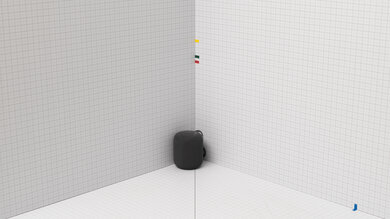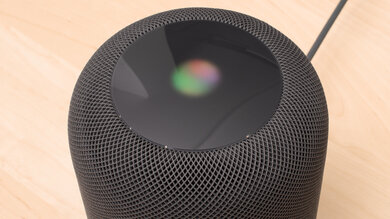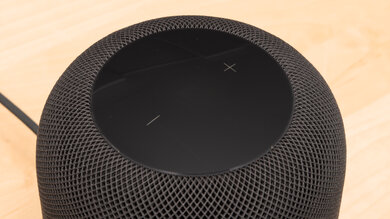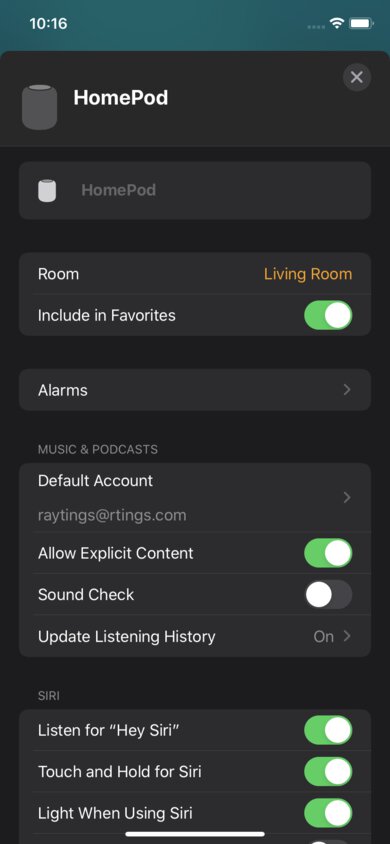The Apple HomePod (1st generation) is a wired smart speaker that's been discontinued and replaced by the Apple HomePod (2nd generation). It has a stylish design that's ideal for home use, with built-in Siri for hands-free control. Link it with other HomePods if you want to spread audio to other rooms in your house, or check out the Apple HomePod mini if you want a smaller version of this device.
Our Verdict
The Apple HomePod 1 is decent for music. It offers an even sound profile out of the box, meaning that voices and lead instruments are reproduced with clarity and detail. It's suitable for listening to lots of different genres, with plenty of low-bass to bring out the rumble in EDM and hip-hop. However, there aren't any sound customization tools on hand, so you don't have any ability to switch up its performance.
- Decently balanced sound profile.
- Great 360-degree soundstage.
- No EQ.
- Doesn't get very loud, with compression artifacts at max volume.
The Apple HomePod 1 isn't designed for watching movies, but if you want to listen to videos streamed on your phone, it can get the job done. You can connect your devices over Wi-Fi and Apple AirPlay, and its low latency means that the audio you hear is in sync with the video you see. Dialogue is clear, too, and there's some rumble in the bass for action-packed scenes, too.
- Decently balanced sound profile.
- Great 360-degree soundstage.
- No EQ.
- Doesn't get very loud, with compression artifacts at max volume.
The Apple HomePod 1 is fair for podcasts. Since dialogue is reproduced clearly, you can easily follow along with your favorite shows. Plus, it gets loud enough for an average-sized room, meaning you can hear every detail. It's not portable, but if you pair it with other compatible speakers, you can mirror your show to other rooms in your home.
- Decently balanced sound profile.
- Great 360-degree soundstage.
- No EQ.
- Doesn't get very loud, with compression artifacts at max volume.
The Apple HomePod 1 is excellent for voice assistant support. Built-in Siri provides hands-free control, meaning you can control the speaker with your voice right from the comfort of your couch. It can also hear your commands if you're further away or if you're in a noisier environment. Plus, you can mute the speaker when you don't want it to hear you.
- Decently balanced sound profile.
- Excellent Siri voice assistant distance performance.
- Great 360-degree soundstage.
- No EQ.
- Doesn't get very loud, with compression artifacts at max volume.
You can only use the Apple HomePod 1 wired, and it isn't suitable for outdoor use.
Changelog
- Updated Feb 28, 2023: Added a market comparison for the Apple HomePod (2nd generation) to the Frequency Response Accuracy box.
- Updated Feb 15, 2023: Minor updates to the text for clarity; no changes in test results.
- Updated Oct 18, 2022: Changed the 'Microphone Mute' test result from 'No' to 'Yes' in the 'Voice Assistant' box after retesting the speaker. Also added information about dismissing an alarm in the 'Controls' box.
- Updated Oct 13, 2022: Changed 'Call Answer/End' test result from 'No' to 'Yes (Tactile)' in the 'Controls' box after retesting the speaker. Minor adjustments to text for consistency.
Check Price
Differences Between Sizes And Variants
The Apple HomePod (1st generation) speaker comes in two color variants: Space Gray and White. These variants are only different in look, and we expect the white variant to perform similarly to our space gray model.
If you come across another variant of this speaker, please let us know in the discussions, and we'll update our review.
Popular Speaker Comparisons
The Apple HomePod first generation speaker has Apple's Siri built-in like the Apple HomePod mini, though it's a bit bigger. It has a mic with excellent far-field performance, meaning you can command Siri with your voice from another room. It also has a 360-degree sound, ensuring clear sound from any angle. However, its functionality is limited to Apple devices, so Android users are out of luck. It's also not very portable since it has a wired design. Its sound profile lacks low bass, and it doesn't get very loud.
See also our recommendations for the best smart speakers, the best home speakers, and the best speakers for iPhone.
The Apple HomePod (2nd generation) is better than the Apple HomePod (1st generation). While both speakers have a similar design, the 2nd generation model can reproduce a more extended low-bass, so you hear more thump and rumble in the mix.
The Apple HomePod (1st generation) is a better smart speaker than the Amazon Echo Studio (1st generation). The Apple has Siri built-in, better controls, a more neutral sound profile, and a wider soundstage. It also has low latency on Apple AirPlay. However, it's been discontinued and may be harder to find in new condition. That said, the Amazon is a Bluetooth speaker with Alexa built-in. It has bass and treble sliders, meaning you can tweak its sound profile. It also gets louder with minimal compression.
The Apple HomePod (1st generation) and the Amazon Echo Gen 4 are both excellent speakers for voice assistants, but the Apple is more versatile overall. Out-of-the-box, the Apple has a more balanced sound profile, and it has a better soundstage. It supports Apple AirPlay, while the Amazon speaker supports Bluetooth. Also, it offers bass and treble adjustments so you can customize its sound. The Apple speaker may be harder to find in new condition since it's been discontinued.
The Apple HomePod (1st generation) is a better speaker than the Apple HomePod mini. The HomePod has a more neutral sound profile and gets louder, too. Also, its built-in Siri has a better ambient noise performance, so it does a better job understanding your voice in noisy settings. The HomePod mini has a smaller, more lightweight design that some listeners may prefer. It's also easier to find on the market since the Apple HomePod has been discontinued.
Test Results

The Apple HomePod 1 is a 360-degree speaker with a very minimalist look. It comes in either a gray or white color, and its overall fabric look doesn't stand out, making it easy to blend into your decor. If you prefer a smaller speaker, consider the Apple HomePod mini instead.
Its build quality is passable. Its top is made of glass that feels premium, and its body is tightly wrapped in fabric that feels a bit rough to the touch. It also doesn't have an IP rating for water resistance, so it's best to avoid placing it in areas where it may get wet, like near a kitchen or bathroom sink.
This speaker has great controls. Its glass top has touch-sensitive controls that appear when tapped to easily control music. While there's no physical control to mute Siri, you can mute it with a voice command and unmute it by pressing into the glass surface and holding for a few seconds. While you can't use its controls to accept an initial call, you can tap and hold the green light atop the speaker when you receive a second call to put it on hold, and you can double-tap it to switch calls. To end a call, tap the green light once. You can also dismiss an alarm by tapping the middle of the touch-sensitive surface.
The Apple HomePod 1 has decent frequency response accuracy. Overall, its sound profile is quite balanced, so voices and lead instruments are reproduced with clarity and detail. As a result, this speaker is suitable for listening to lots of different types of audio content, from music to podcasts to audiobooks. There aren't any sound customization tools available, but you may find that you don't need them. That said, it still doesn't bring as much rumble in the low-bass as the Apple HomePod (2nd generation).
Its soundstage performance is good. Thanks to its 360-degree design, it has outstanding directivity, resulting in an open and natural-sounding soundstage. That said, you need to pair it to another HomePod speaker to play stereo audio and downmixes stereo content to mono when using it on its own, which isn't as immersive.
The speaker's dynamics are alright. It doesn't get loud enough to fill a large crowded room, though it'll be fine if you're using it at home. That said, there's some compression present at max volume, especially in the bass range, so your audio may not sound as clean during louder listening sessions.
The speaker offers excellent voice assistant support with Siri built-in. You can activate Siri with your voice, and it has no trouble understanding your commands from far away and in noisy settings. That said, while you can disable Siri, there isn't a physical button you can use to mute its mic, so you need to mute it with a voice command. You can then press and hold the glass surface to reactivate Siri. For smart speakers with physical mic mute buttons, check out the Google Nest Audio or the Amazon Echo Dot Gen 4.
Apple Home is an alright companion app. While it's easy to use, it's only available for iOS devices. It's pretty barebones in terms of features, and there isn't a graphic EQ or presets you can use to tweak its sound to your liking. On the upside, you can pair it with other Apple HomePods when you want to create a stereo pair or when you want to play different audio in different rooms across your home at the same time. If you're looking for a home speaker with an app that lets you adjust the bass and treble, check out the Google Nest Mini, Denon Home 350, or the Amazon Echo Gen 4.
This speaker doesn't have any physical inputs other than the attached charging cable.
The Apple HomePod 1 is listed as having Bluetooth 5.0, but you can't use it for directly pairing or playing audio. It's used for audio handoff, which allows you to transfer audio from your iPhone to the speaker or vice versa by tapping your device on the top of the speaker. If you want to stream content using this configuration, your iOS device must be connected via Bluetooth to the same Wi-Fi as this speaker. However, if you're using an iPhone, you can also use Apple AirPlay to wirelessly play audio. If you're looking for a home speaker that supports Bluetooth, consider the Bose Home Speaker 300 or the Bose Home Speaker 500.
This speaker is Wi-Fi compatible. While it has very low latency using Apple AirPlay, it delays video to compensate for audio latency, so there's a noticeable delay between the time you press play and when the video plays.







